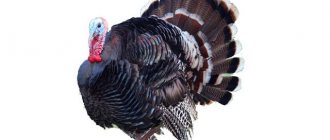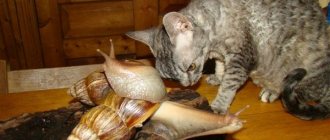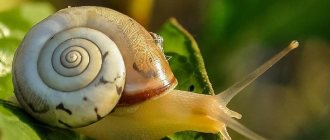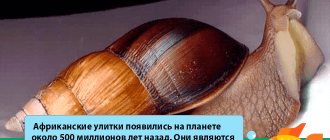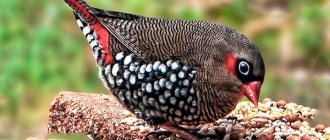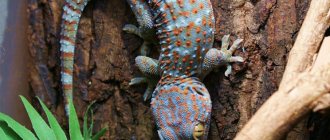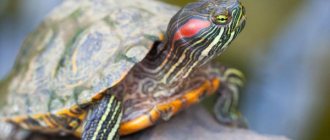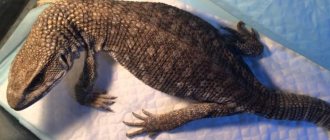Brief characteristics and description of African snails
In their natural habitat, these creatures are considered dangerous pests that affect many crops, but now people often keep Achatina as pets.
These snails are native to Africa. They are often found in regions with tropical and subtropical climates, where high humidity and sufficient plant food are maintained throughout the year. There are at least 60 varieties of these creatures. The animal's body is soft. The shell has an oblong, pointed shape. It reaches 30 cm. The color of the “house” can be:
- swamp;
- black-brown;
- brown with dark stripes, etc.
In addition, snails with white shells are relatively rare. They are smaller in size. Some individuals have yellow markings. The color scheme of the shell largely depends on the diet.
In most cases, it darkens with age. The shell of these creatures is always twisted counterclockwise. In adults, it includes from 7 to 10 turns. The weight of these creatures can range from 0.3 to 0.45 kg. The body of this creature is beige or dark brown.
Achatina has well-developed sense organs.
The eyes, located on long horns, are able to recognize lettuce at a distance of 1 m. In addition, these creatures have a developed sense of smell, allowing them to identify food located at a distance of 1.5 m. These snails have a well-developed memory, so they are able to remember the owner and distinguish him from other people.
Priming
For newborn Achatina leaves, lettuce and cabbage are usually used as soil. The kids sit on these leaves and eat, gaining strength. If small snails are in a terrarium with soil, then give preference to fine coconut substrate and flower soil without fertilizers. It is better to avoid moss in the first months. Sand, stones and sawdust are strictly prohibited as soil. Which soil to choose.
Varieties of Achatina snails
There are many varieties of these snails in nature, but not all of them are suitable for home keeping. The most commonly kept varieties as pets are fulica and reticulata. These creatures require similar conditions, but they differ in appearance.
Achatina fulica has a variegated shell color. Its color may vary depending on the animal's diet. The body has a brown or brownish tint. These creatures are extremely slow. They spend most of their time motionless. Caring for them is simple, so even a child can be trusted with it.
Achatina reticulata is characterized by greater mobility. These creatures are inquisitive and always try to examine the surrounding space, raising their heads and extending their horns. Their shell has a beautiful pattern consisting of stripes and dots. The body is dark brown or black.
Varieties
Over 60 species of Achatina live on the African continent. At home, it is customary to keep only a few species.
Kinds:
- Fulika.
- Reticulata.
- Immaculata.
- Albopicta.
- Iradelie.
- Brown.
- Tiger.
- Zanzibarika.
- Standard.
- Panther.
- White albino.
Snails make great pets for children. Many children love to play with them, and parents do not have to worry that the pet will harm their baby.
Children are interested in calling Achatina names and caring for them. In reality, snails are much more beautiful and larger than in the photo. They have a more pronounced color and a longer body.
Achatina snails are popular not only in real life, but also in computer life. Today there is one game ARK: Survival Evolved, where these mollusks are the main characters.
Useful video
Share this post
- Related Posts
- Step-by-step instructions for beginners: starting an aquarium and how to choose unpretentious plants
- Description of parrot fish and how to care for them?
- What you need to know about Pekingese dogs, how to care for them at home?
- What are swordtails and how to care for them
- Description and characteristics of rated dog breeds by intelligence
- Types of cichlids with descriptions, compatibility with other fish. How to maintain, what to feed and how to reproduce?
Composition of mucus and beneficial properties of the Achatina snail
The mucus of these creatures is used to treat a number of diseases and eliminate some cosmetic problems. This largely explains the increased attention to the creatures.
During their life, these snails secrete a special mucous secretion onto the surface of the skin.
It is necessary for the creatures themselves to protect the soles from abrasion and improve gliding on the surface. In addition, the secretion prevents the shellfish skin from drying out. Achatina mucus contains many useful substances, including:
- collagen;
- allantoin;
- lectins;
- elastin;
- vitamins A, E, B, C;
- peptides;
- glycolic acid.
Collagen helps maintain the firmness and elasticity of the skin. Elastin, which is part of mucus, also helps maintain the elasticity and smoothness of the skin. A component such as allantoin has a pronounced antioxidant effect, therefore it prevents the appearance of free radicals and helps to launch regeneration processes.
The vitamins contained in mucus can protect the skin from premature aging. Peptides have an antibacterial effect. Lectins and glycolic acid help cleanse the skin of impurities and dead cells.
Biologically active compounds present in the mucus of these creatures have the following effects:
- reduce expression wrinkles;
- rejuvenate the skin;
- lighten age spots;
- moisturize the dermis;
- smooth out scars;
- reduce the inflammatory process;
- helps eliminate acne.
This type of mollusk is often used in cosmetology to eliminate many skin imperfections. In addition, in folk medicine, the mucus of these creatures is used in the treatment of infectious diseases of the upper respiratory tract, eliminating signs of varicose veins and psoriasis. The mucus has a mild analgesic effect. In the regions where these creatures live, they are often eaten to treat and prevent diseases of the gastrointestinal tract and improve the functioning of the nervous system.
What is needed to keep a snail and how much does it cost?
For residents of Russia
- Infographics
- Table
At the pet store:
| № | Name | Cost, rub |
| 1 | Snail Achatina | from 40 |
| 2 | Terrarium | from 1000 |
| 3 | Plastic container | from 100 |
| 4 | Soil for bedding | from 100 |
| 5 | Thermometer, hygrometer, thermal cord, spray bottle | from 200 |
| 6 | Bark, driftwood, branches, fresh flowers | from 100 |
| 7 | Vegetables, fruits, cereals, food chalk, gammarus | from 150 |
On Avito or AliExpress: The cost of the Achatina snail is from 10 rubles; The cost of the terrarium is from 500 - 5,000 rubles; The cost of a plastic container is from 400 rubles; The cost of soil for a terrarium is from 60 rubles; Thermometer, hygrometer, thermal cord, spray bottle - from 100 rubles; Decoration: bark, driftwood, branches, live plants - from 50 rubles; Feeding costs: sepia, food chalk, dry fish food - from 80 rubles.
The use of Achatina snails for medicinal purposes
Large individuals of this species are often used for cleansing and regenerating massage. Before the procedure, the animal’s facial skin and soles are cleaned in a special way. After this, the animals are seated so that they move along the massage lines. This helps improve blood flow and restore skin structure. The procedure lasts from 10 to 30 minutes. After this, the snails are removed, and the secretion is left on the skin for another 15 minutes. The skin is then washed and a moisturizer is applied.
Collected snail mucus can be used to prepare masks and compositions used for medicinal and cosmetic purposes.
Additional components may be added to such products to enhance the effect.
Banana tightening mask
This mask has a nourishing, moisturizing and whitening effect. It is not difficult to prepare such a composition. You need to take about ½ of a ripe banana and grind it thoroughly in a blender until it becomes mushy. To this component you need to add 1 tsp. snail mucus and ½ tsp. fat sour cream.
All ingredients should be mixed thoroughly. Before the procedure, you should steam and cleanse the skin. The mask is applied to the skin for 30 minutes. The remaining composition should be washed off with warm milk. This composition should be used 2 times a week to achieve a lasting effect.
Snail mask with vitamin E
To smooth and saturate the skin with nutrients, you can use a mask containing snail mucus and vitamin E. To prepare the composition, take approximately 1 tsp. mucous secretion of a large snail. Add 1 tsp to it. warm milk and 1 capsule of vitamins E and A. These components should be mixed thoroughly. Approximately 1 tsp should be added to the composition. corn starch.
All components of the mask should be thoroughly mixed again. The skin must be steamed and cleaned before applying the mask. After this, the composition is applied to it. You should keep this mask for at least 10-15 minutes. Rinse off any remaining residue with warm water. It is recommended to carry out this procedure no more than 2 times a week. This will be enough to achieve a positive effect without the risk of damage to the upper layers of the epidermis.
Oatmeal mask
To deeply cleanse the skin, eliminate acne, signs of inflammation and preserve the youth of the epidermis, you can use a mask containing large snail mucus and oatmeal. To prepare the composition, you must first grind the oatmeal in a coffee grinder. After that, to 1 tbsp. add about 3 tablespoons of ground oatmeal. strong decoction of chamomile or string. Approximately 1 tsp is added to these components. mucus.
After thoroughly mixing all the components, the composition must be applied to the area of the nasolabial triangle, forehead and around the eyes. You need to keep this mask for at least 20 minutes. Rinse off the remains with warm water or herbal decoction. Regular use of such masks helps improve skin structure. After about 10-15 sessions, blackheads are eliminated and pores are narrowed. With daily use, a tightening of the facial contour is observed.
Against cellulite
Large Achatina snails are often used to eliminate signs of cellulite. The active substances contained in the mucus of these snails smooth out the skin structure, improve tissue nutrition and eliminate dead elements. To achieve a positive result, it is necessary to carry out anti-cellulite massage 3 times a week, using mucus instead of oil.
The problem area should be developed for 15 minutes in 1 session. To achieve a positive result, it is necessary to carry out the procedures for 1 month. If cellulite is severe, the duration of the course of using such masks can be increased to 3 months.
Against varicose veins
Large snails can be used to eliminate signs of varicose veins. The massage effect that these creatures have during movement, as well as the active substances contained in the mucus, are especially effective in the early stages of the disease.
Before the procedure, the skin that will be exposed should be thoroughly cleansed. The snails must be washed under running water, then placed on the skin, allowing them to move freely. Animals must remain on the skin for at least 20 minutes. After this, they are removed and a thorough massage is carried out for 25 minutes, rubbing the remaining mucus into the skin. Remains of the substance must be washed off with warm water.
Treatment of psoriasis
The use of Achatina snail mucus can reduce the intensity of psoriasis symptoms. The snail rash should be applied to areas every day. Their mucus helps reduce inflammation and flaking. In addition, it gives a moisturizing effect. Active substances present in mucus help activate regeneration processes.
The very observation of these creatures has a pronounced anti-stress effect.
It is recommended to keep them as pets for people suffering from psoriasis, because... This disease is largely psychogenic in nature.
Watching animals helps relax the nervous system.
Collecting mucus from a snail
Collecting mucus is safe and the process is painless for the snail. You should take a teaspoon in one hand, and a snail in the other, which you first need to stroke in order to activate the production of the beneficial substance. After this, the animal must be turned over and begin to carefully scrape off the mucus from its sole. In about 10-15 minutes, you can collect about 1 tsp from a large individual. This is enough to prepare a mask. If there are several snails available, you can collect from all individuals. It is not worth storing mucus for a long time, because... beneficial substances may be destroyed.
Cleaning a terrarium with snails
Uneaten food and feces should be removed every day. If this is not done in a warm, humid environment, midges, mold and bacteria quickly grow. Then an unpleasant odor appears and parasites may appear. The snails themselves have no smell; the smell is of decaying food debris. When cleaning a terrarium with small Achatina, carefully inspect uneaten lettuce and cabbage leaves before throwing them in the trash. Sometimes babies can sit on them.
Keeping at home: terrarium and climate
These snails do not require the creation of specific conditions. They can be kept in a terrarium in any apartment or house. At the same time, it must be taken into account that it is desirable for these creatures to create conditions close to natural. To keep one individual you will need an aquarium or terrarium made of plastic or glass with a volume of 5 liters. The larger the container, the faster and larger the clam will grow.
The snail's home must have a lid with holes for ventilation, because... These creatures can easily move along the walls. The bottom of the terrarium should be sprinkled with a special substrate or peat. You can also use soil, but then the snails and the walls of the container will always be dirty. The thickness of the litter should reach 4-7 cm, because snails love to burrow into it.
In the terrarium you can place decorative clay pots, shards and driftwood, under which the snails can hide. You can plant moss, fern or ivy. It is allowed to place artificial plants in the container, because natural ones can be eaten by snails. In the terrarium you need to place a feeder with low sides and a drinking bowl. The temperature in the container should be about +20..+25 °C. Air humidity should be 70-85%. The terrarium should not be exposed to direct sunlight. The backlight should be moderate.
Basic requirements for a comfortable life
Large African clams require high-quality maintenance and care. Therefore, among the requirements for keeping Achatina are a properly selected house and an optimal temperature in it, which will not allow the mollusk to hibernate and will not lead to increased metabolism.
The soil should be poured in a layer up to 5-7 cm, and for the tiger snail the height should be 11-16 cm, since this species prefers to bury itself entirely in the substrate. The listed requirements for care and maintenance are basic, but not the only ones that hives need.
Selection of capacity
An aquarium or other reservoir is selected at the rate of 10 liters to support one individual. However, if the goal is to have two or three individuals or more, then you should make sure that the capacity of the tank exceeds 30 liters.
Read more about different types of terrariums and the requirements for them in our article.
Large snails are incredibly inquisitive and love to get to know the outside world, which is outside their house. They are smart, but not smart enough to understand how dangerous traveling on their own is for their lives.
This is what happens when the volume of the terrarium is not enough. Here it’s not just cramped conditions – it’s definitely offensive!
For safety reasons, the aquarium is covered with a lid on top. Its role can be assigned to a piece of transparent “breathable” - that is, having holes - plastic. If the owner plans to leave, it is important to make sure that Achatina cannot lift the lid and get out.
Heating and ventilation
African land snails prefer a warm climate - partly this fact explains why Achatina still does not spontaneously reproduce in Russia. Here, the heat-loving African snail is simply cold. The temperature in the aquarium must be adjusted within 22-27 degrees with a plus sign.
If the house is not warm enough to support a heat-loving mollusk, a dim lamp will become an additional source of heating. If the temperature drops below the specified values, the Achatina snail will become lethargic and may go into hibernation, from which it may not emerge later.
Ventilation also plays a big role in creating good living conditions for shellfish. They provide balance between humidity and temperature.
Selection and arrangement of substrate (soil)
Domestic Achatina, like their wild relatives, love to burrow into the ground. Therefore, the base of the house needs to be thicker, from 11 cm or more. Soil requirements: looseness and good ventilation. In the future, Achatina will lay eggs in it.
A good option is coconut substrates or soil for flower pots, which is sold in any specialty store. The only condition is the absence of fertilizers and other harmful chemicals.
It would be a mistake to keep Achatina at home in sand or walnut shells, as well as in sawdust and loam.
Buy dry coconut substrate for snails on Aliexpress - it's cheaper and easier.
Regardless of the type of soil, it should be moistened, but not wet. This way the tank will maintain a constant level of humidity.
Maintaining optimal humidity
The content, as already mentioned, requires certain temperature and humidity regimes suitable for snails to live. These mollusks are tropical animals, and the tropics are humid all year round. Accordingly, the higher the air humidity, the easier life is for Achatina. Acceptable values are 80-90%. But everything is determined individually.
If your pet tries to hide in the sink, it means it is suffering from dry air.
. Constant presence on the walls is evidence of high humidity.[/info-box]
Dryness can be eliminated by moistening the soil and placing a bowl of water. The snail will happily swim in the bowl. The only thing: the bowl must be held steady, otherwise the pet will knock it over or choke. From time to time, the water in the bowl must be renewed.
Decorating and arranging the terrarium
Mollusks react to light, so it matters for keeping whether it is light or dark outside the window. Animals are most active at night, and during the day they burrow into the substrate and other places. Decorative elements can be used as such nooks:
- coconut shell;
- decorative stones;
- driftwood;
- grass or fern.
A large selection of products for terrariums on the Aliexpress website. There is original decor, heating mats, and humidifiers. As well as thermometers and hygrometers for any choice.
The Madagascar snail will appreciate a plant such as ivy. It will serve Achatina not only as shelter, but also as food. However, Achatina will not disdain ferns and other types of plants either.
But piercing and cutting objects should be avoided. They are dangerous for the mollusk and can harm the body and fragile shell.
Handle your pet carefully
Despite their size, large Achatina are very vulnerable. Neglect and careless handling of shellfish can result in damage to the shell. In some cases, damage to the shell of giant Achatina is corrected with special ointments such as propolis, as well as with epoxy glue and enhanced calcium-containing additives. But in critical situations, damage to the shell leads to death.
Caution must be observed at any time when the Achatina snail is sent into the hands of the owner and other people.
Do you often pick up/give your snail?
Feed vegetables and greens once a day
Caring for adult Achatina requires a variety of products. After all, gastropods eat almost everything. But preference should be given to plant-based foods. The best option is vegetables.
Green is allowed, yellow is allowed with caution, and red is not allowed at all!
What to feed Achatina? Here is a sample list of products:
- lettuce leaves;
- dandelion;
- clover;
- apples;
- cucumbers;
- pumpkin;
- tomatoes;
- zucchini.
In addition to the above, the African snail's diet should include calcium and supplements containing it - for example, ground shells or chalk. Egg white, chicken or animal meat are suitable as protein. But you should give it occasionally, without abusing it.
It is enough for a young snail to eat once a day, but adults can eat once every couple of days.
Since the snail is an animal that is active at night, it is best to feed it in the evening.
Controlling the appearance of masonry
An adult Achatina can lay up to a thousand eggs per year or more at home. At one time, the mollusk lays 250-300 eggs. From this amount, after 2 weeks, an offspring of 6-7 mm in size appears.
But in order for Achatina to lay eggs, she needs a partner. Although most land snails are hermaphrodites, they cannot reproduce without a partner. But even if Achatina is now kept alone, but has had contact with another snail, it can lay a clutch. Read more about reproduction in our article. In addition, the gastropod must reach maturity. Usually it occurs no earlier than six to seven months after birth.
Keep it clean
Another point regarding the question of how to keep Achatina in an apartment is related to the cleanliness of her home. The content assumes that the mollusk will be provided with its own house - at home, an aquarium or other tank is used in its role.
The pet's home needs periodic cleaning - about a couple of times a week. Once a month you need to carry out general cleaning - change the soil, wash the walls of the aquarium on both sides.
It is prohibited to use chemical cleaning agents. Only hot water, rags and a simple dishwashing sponge are acceptable.
Beautiful snail - healthy!
Achatina snails are considered not too vulnerable to infections and diseases. But due to incorrect conditions of detention, they can get sick.
Most often, improper snail care is as follows:
- overheating or hypothermia of Achatina;
- the aquarium is of insufficient volume;
- ignoring the procedure for moistening the soil;
- lack of air conditioning and ventilation;
- insufficient calorie diet with low protein and calcium content.
The disease is indicated by a lethargic state, refusal to eat, withdrawal into a shell, or discharge with too thick mucus. In some cases, the shell begins to peel off. And if the snail falls out of its shell, then most likely the process is irreversible and the pet cannot be returned.
And in such cases, long-term treatment with calcium and glue is needed...
Good care and careful monitoring of Achatina snails at home will help prevent diseases. Animals need to be provided with supplements containing calcium, feed should be selected wisely and preventive measures should be taken: cleaning the aquarium, bathing the shellfish.
What do snails eat?
Snails feed mainly on plant foods. Snails eat well at home:
- bananas;
- tomatoes;
- carrot;
- sweet bell pepper;
- salad;
- cabbage;
- boiled potatoes;
- boiled porridge.
You can give bread soaked in milk in limited quantities, as well as boiled eggs. Milk and sour cream should be added to the snails' diet periodically. In summer, it is advisable to give your pets fresh dandelion leaves, clover, berries and fruits. In addition, you can feed the snails with meat puree, bone meal and gammarius.
With a lack of calcium, snails can attack their relatives, gnawing on their shell.
To avoid this, animals should be periodically given:
- cottage cheese;
- feed chalk;
- sepia;
- pumpkin seeds;
- eggshell powder;
- unleavened cheese.
It is advisable to grind the food in a blender before giving it to the snails. Achatina snails should be fed in the evening. Small snails need to be given food every day. Adults need to be fed 2-3 times a week. At the same time, you need to ensure that the snails have constant access to clean water.
What to feed Achatina snails?
Achatina are not picky creatures. You don’t even have to feed them for 2-3 weeks, but in this case the snail will go into suspended animation (a state in which life processes slow down).
In other words, suspended animation is hibernation. If they fall asleep, the only way to wake them up is with water.
What do Achatina eat:
- Apples.
- Pears.
- Apricots.
- Grape.
- Melon.
- Bananas.
- Watermelon.
- Papaya.
- Avocado.
- Pineapples.
- Cherries.
- Cucumbers.
- Tomatoes.
- Carrot.
- Corn.
- Dill.
- Parsley.
- Spinach.
- Celery.
- Dandelion leaves.
- Bread.
- Milk.
- Hercules.
- Boiled eggs.
- Chopped nuts.
Snail nutrition should not be monotonous. Leftover food is always removed to prevent mold and fungal growth.
To improve the color of the shell, Achatina is fed with carrots, pumpkin, sweet peppers, tomatoes, nettle and plantain leaves.
Caring for Achatina snails at home
It is enough to clean the terrarium and replace the bedding 1-2 times a month. In this case, it is imperative to rinse the inside of the container well. When using chemical detergents, it is necessary to rinse the terrarium thoroughly.
These creatures need regular hygiene procedures. To bathe a snail, you need to place it in the palm of your hand and place it under running warm water. You shouldn't apply a lot of pressure. Snails tolerate such procedures well, stretching out with their whole bodies, trying to get water to all areas of the skin. The duration of the procedure should be 3 minutes. It is advisable to arrange a shallow but stable mini-pool in the terrarium.
How to set up a terrarium for Achatina?
These mollusks are inhabitants of the subtropics and in temperate climates they suffer even with minor cold snaps. It’s easiest to create ideal conditions in an enclosed space, so the best way to set up a terrarium is to use a familiar glass fish aquarium. It is easy to protect pets from drafts, maintain a temperature of up to 25°C around the clock, and create a humid environment. Achatina snails are very sensitive creatures; care without proper attention leads to the death of pets or a sharp decrease in their activity.
The volume of the terrarium is on average 10 liters per adult mollusk. The freer the space in the aquarium, the larger exotic pets grow. You will definitely need a lid with holes drilled for ventilation; without it, creatures can escape outside. Ideally, Achatina snails require a house with a height of 20 cm and a length of 30 cm. It is forbidden to install it in the sun; under open rays, the mollusks die from dehydration.
What is needed for Achatina snails in a terrarium:
- We arrange the soil in the aquarium from soft material - sphagnum moss, coconut substrate.
- You need to purchase several bowls for the terrarium to perform individual tasks - for grain mixture, for calcium-based supplements, for everyday nutrition.
- We make bathing suits of such depth that Achatina does not accidentally choke.
- In a ceramic container, a pet can damage the sink if it accidentally falls, so it is better to buy a plastic device.
- We secure the baths firmly so that they do not tip over.
- For Achatina snails, care is unthinkable without constant monitoring of the quality of the external environment. Be sure to install an accurate thermometer and hydrometer in the terrarium.
- For cleaning you will need a good separate sponge, which is strictly forbidden to be dipped in aggressive detergents or used for other purposes.
- Buy and always keep a spray bottle filled with clean water nearby.
Reproduction and care of eggs
These mollusks reproduce well in captivity. They reach sexual maturity at 6 months. These creatures are hermaphrodites. In this case, the role of the female is always taken by the largest individual, because it has large reserves of nutrients. After fertilization, this creature can store its partner's sperm for up to 2 years. Achatina can give birth to offspring up to 6 times a year. Gestation lasts about 2 weeks. The offspring are formed near the respiratory opening.
Before laying eggs, the individual burrows into the ground. This process takes 2 days. At one time, the female lays from 200 to 400 eggs. Most of them are viable. They do not require special care. At the same time, high air humidity should be maintained. After about 2-4 weeks, small snails hatch. Newborns should be separated from adults in a separate terrarium. You can feed them the same food as adults.
Features of feeding
What to feed small Achatina snails in the first week of life? Experienced terrarists advise putting food on lettuce leaves and pouring ground eggshells and crushed fish food - dried gammarus crustaceans - on them. Crustaceans can be replaced with shell rock, cuttlefish shell, edible chalk or bird stone ground in a coffee grinder. Such drugs are sold in pet stores and it is important to monitor their quality and expiration date. Before feeding Achatina, mineral supplements must be thoroughly crushed into powder and mixed. Store the mixture in a container with a tight lid and add the hatched snails to their diet at each feeding.
What to feed small but already grown snails so as not to harm their health and digestive system, and maintain their stable growth and development?
In the first 2-3 weeks, newborn snails are in dire need of fresh herbs, fruits, vegetables and calcium-containing food. Carrots, pumpkins, cucumbers or apples must be peeled, cut into thin transparent slices, placed on a lettuce leaf and sprinkled with a mineral supplement. But under no circumstances should you give small Achatina bananas, loose peaches or soft tomatoes. In the juicy pulp of the fruit, small Achatina children can choke or suffocate.
On a note! Actively growing snails, due to a lack of calcium, may begin to eat the shells of their fellows. It is important to monitor the condition of Achatina babies daily and provide them with the necessary calcium-containing products.
At the age of 3-4 weeks, small Achatina snails are already quite strong and active. At this time, breeders usually distribute grown-up pets into good hands. Teenagers of Achatina eat the same thing as their adult relatives. They prefer to stay awake every day in the evening and enjoy fresh vegetables and fruits.
If the breeder took care and followed the rules for caring for the snails, then after 6 months the young animals will safely move into an adult aquarium, and healthy snails will be ready for mating.
Daily observation of slow-moving pets, care and increased attention will tell the owner how to care for small snails. But it’s even better to read more useful literature to find out what experienced terrarium keepers feed baby Achatina. Important information and tips will help keep the cute Achatina snails healthy and in a good mood.
